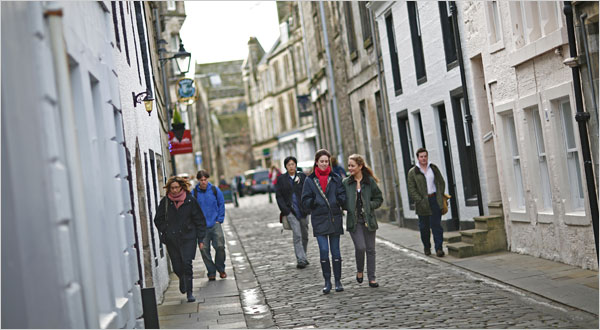 |
|
| Going Off to College for Less (Passport Required) | |
| N.Y. Times, December 1st, 2008 | |
 |
Isobel
Oliphant, center, and her friend Savanna Cummin attend St. Andrews in
Scotland. |
| By TAMAR LEWIN | |
| Global Classrooms | |
| Abroad for a Bachelor's | |
| ST. ANDREWS, Scotland - Isobel Oliphant felt she was making an offbeat choice when she graduated from Fox Lane High School in Bedford, N.Y., and enrolled at the ancient university in this quiet coastal town of stone ruins and verdant golf courses. | |
| “I thought I was being original,” said Ms. Oliphant, now in her third year at the University of St. Andrews. “But my high school class president came here, too. And when I got here, it was all ‘Hi, I’m from Massachusetts,’ ‘Hi, I’m from New York.’ ” | |
| St. Andrews has 1,230 Americans among its 7,200 students this year, compared with fewer than 200 a decade ago. The large American enrollment is no accident. St. Andrews has 10 recruiters making the rounds of American high schools, visiting hundreds of private schools and a smattering of public ones. | |
| With higher education fast becoming a global commodity, universities worldwide -many of them in Canada and England - are competing for the same pool of affluent, well-qualified students, and more American students are heading overseas not just for a semester abroad, but for their full degree program. | |
| Ryan Ross of Annapolis, Md., applied only to St. Andrews; McGill University in Montreal; and Trinity College in Dublin. “I knew I wanted a different experience,” said Mr. Ross, now a freshman studying international relations at St. Andrews. | |
| The international flow has benefits, and tradeoffs, for both sides. | |
| For American students, a university like St. Andrews offers international experience and prestige, at a cost well below the tuition at a top private university in the United States. But it provides a narrower, more specialized course of studies, less individual attention from professors — and not much of an alumni network to smooth entry into the workplace when graduates return to the United States. For overseas universities, international students help diversify campuses in locations as remote as coastal Fife, home of St. Andrews. | |
| Just as important, foreigners are cash cows. While students from Scotland and England and across the European Union pay little or no tuition at St. Andrews, Americans pay about what they would as out-of-state students at leading American public universities. | |
| Although admission to St. Andrews is intensely competitive for European students, with at least 10 applications for each seat, many Americans who would be long-shot applicants at Ivy League schools can find a place at St. Andrews. | |
| “I applied to, and got into, some American liberal arts colleges, like Skidmore and Trinity,” said Savanna Cummin, a St. Andrews student who was not admitted to Brown or Harvard. “But I thought my time and my money would be better spent here, that I’d get more out of the experience, and it would be a better credential.” | |
| Stephen Magee, the vice principal at St. Andrews, sees no problem with admitting Americans who may be marginally less qualified than the European students. | |
| “Am I wrong to say I don’t care if they can’t get into Harvard?” Mr. Magee said. “If a Scottish parent asked why their very talented child did not get in to St. Andrews, when so many Americans did, I would tell them to ask the government, which encourages us to take international students, but caps the number of local students they will pay for.” | |
| Mr. Magee emphasizes that Americans are not displacing homegrown students, since St. Andrews would not be allowed to admit additional applicants from Scotland or England if it cut back American admissions. | |
| The Americans at St. Andrews cluster in a few departments: art history, English and, especially, international relations, where more than 100 of the 350 freshmen are American. | |
| St. Andrews, its reputation burnished by Prince William’s recent attendance, is not the only ancient Scottish university with an influx of Americans. The University of Edinburgh has more than 1,250 American students, many drawn by the veterinary program, although they are less visible among its 25,000 students. | |
| Expatriate education is expanding. This fall, at the National Association for College Admissions Counseling conference in Seattle, where admissions officers from American universities mingle with the counselors who help shape high school students’ college choices, there were representatives from the University of Waikato in New Zealand, Seoul National University in South Korea, Jacobs University Bremen in Germany, the University of Limerick in Ireland, as well as dozens more from Canada and Britain.... | |
 |
|
| Comment: | Good luck with understanding the locals. |
|
 |
||
The
full article is available at: |
||
http://www.nytimes.com/2008/12/01/education/01scotland.html?_r=1&ref=us |
||